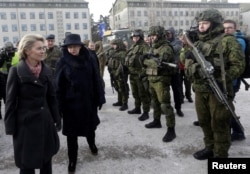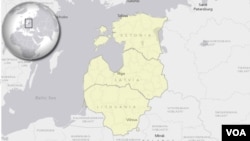A German-led NATO battle group of tanks, armored vehicles, and troops, including Lithuanians, engaged “enemy attackers” mid-March on a field outside a military base in Rukla, Lithuania.
The NATO group fired flares, smoke canisters, and blanks for what a press officer said was the first demonstration of maneuvers since they arrived in Lithuania earlier this year.
A group of visiting German military and other European dignitaries watched from nearby stands.
“We are from Norway, we are from Belgium and from the Netherlands. We all accomplished a very high intensity training,” said Lieutenant-Colonel Christoph Huber, commander of the NATO enhanced Forward Presence Battle Group, and the German contingent in Lithuania. “And, we are prepared to deter and to defend Lithuania.”
NATO is sending additional troops to the Baltics to reassure the former Soviet states against a resurgent Russia, which described the deployment as threatening its security.
NATO troops
After Russia’s 2014 annexation of Ukraine’s Crimea, NATO agreed to send troops to Lithuania and to Estonia, Latvia, and Poland in a move to deter potential Russian aggression.
Russia’s military drills and increased buzzing of NATO airspace have raised concerns among Baltic states, which rely on NATO policing for defense.
NATO jet scrambles to intercept Russian warplanes approaching NATO member airspace jumped from an estimated 400 times in 2014 and 2015 to 800 times in 2016.
“We are protecting NATO airspace, NATO borders,” said Major Martin, commander of the Netherlands Air Force Detachment for NATO’s Baltic air policing in Siaulai. “And, it is not necessarily just the Russians - it’s any aircraft that does not comply with the rules that we ... that apply in the air.”
U.S. President Donald Trump’s demand that NATO members pay more for their defense is welcomed by the Baltic states but there is concern that his push for better U.S.-Russia relations not sacrifice their interests.
“We do hope that such kind of relations will not create new spheres of influence; no more Yaltas Two; and of course they should not be contrary to the international law as we know it,” said Latvia Foreign Minister Edgars Rinkevics.
Building a fence
Lithuania is taking measures that include building a fence this year along its open border with Russia’s Kaliningrad. The main purpose of the fence is to prevent smuggling, but there are also concerns about Russia.
“Well, as I say, we have to be prepared for the worst,” said the Lithuanian Ministry of Defense’s Political Director Vaidotas Urbelis. “Provocations could happen. And, we saw an incident on the Estonian border where one officer was just kidnapped.”
The September 2014 incident on the Estonian border raised concern that Russia planned to use the same hybrid warfare techniques on the Baltics that it used to seize Crimea and still employs in eastern Ukraine.
Sandwiched between NATO members Lithuania and Poland, Russia’s Kaliningrad enclave is a strategic, military outpost housing its Baltic Fleet. Russia recently moved a S-400 missile defense system and nuclear capable Iskandar ballistic missiles to Kaliningrad, citing military posturing from NATO.
Some residents are worried about the potential for conflict.
"Because the Kaliningrad region is quite small and many people are quite concerned about that, including us,” said resident Ekaterina who only gave her first name.
Won't take a risk
Others are less concerned.
"I do not think that someone would take such a risk. I do not think that both NATO and the European Union are in a hostile mood,” said a resident who identified himself only as Ilya. “The issue is with our president (Vladimir Putin),” he added.
Just in case, Baltic states urged NATO to take additional security measures in the region ahead of a Russian September military exercise in neighboring Belarus, which some fear is much larger in scale than reported.
Lithuanian President Dalia Grybauskaite in February described Russia’s Zapad 2017 drills as “a very large and aggressive force that will very demonstrably be preparing for a war with the West.”
Russian state media on Tuesday reported the joint Russia-Belarus exercises involve around 3,000 Russian troops, 280 pieces of hardware and up to 25 Russian aircraft.
Belarussian President Alexander Lukashenko on Monday invited NATO observers to the drills in an effort to increase transparency. "We are not hiding and should not hide anything. If NATO representatives want to be present at our drills, you are welcome. Moreover, I’m already receiving such information and such signals from them,” he said.

